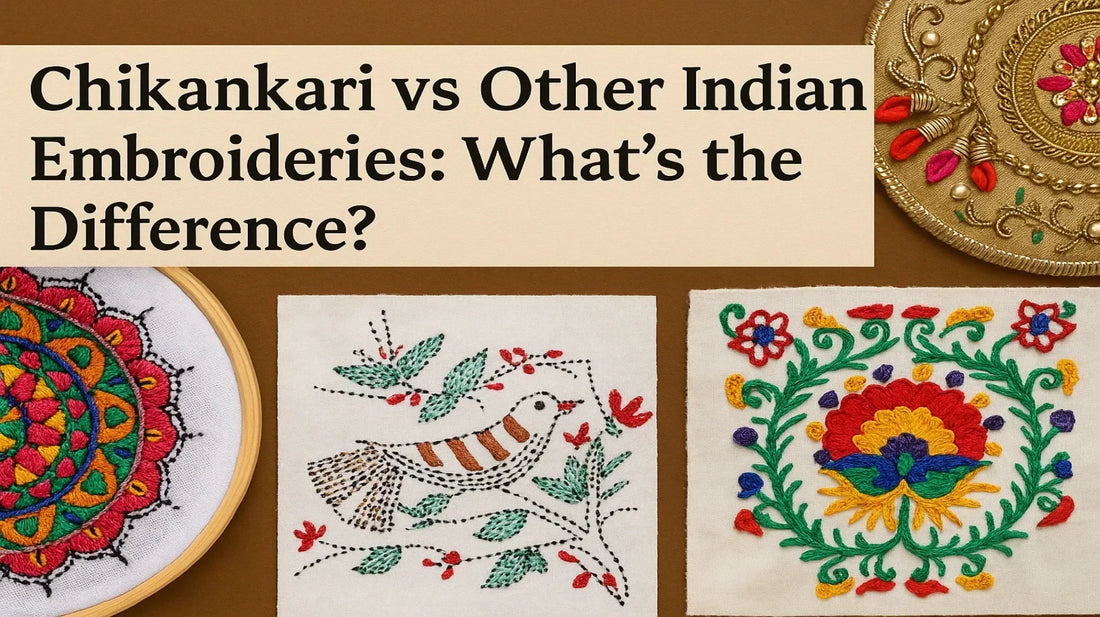
Chikankari vs Other Indian Embroideries: What’s the Difference?
Share
Chikankari: The Art of Subtle Grace
Origin:
Rooted in the royal courts of Lucknow, Uttar Pradesh, Chikankari is believed to have been introduced by Noor Jahan, the Mughal Empress. Over time, it became a signature of Nawabi fashion — understated yet regal.
Stitch Identity:
Chikankari relies on delicate hand embroidery using white thread on light fabrics like muslin, mulmul, cotton, or georgette. Unlike most Indian embroideries, it avoids shimmer or bold motifs. Instead, it focuses on fine, shadow-like stitches — like tepchi, bakhiya, murri, and phanda — that almost melt into the fabric.
Mood:
Soft, airy, and ethereal. Chikankari doesn’t demand attention — it earns admiration quietly. It’s like poetry in cotton.
How Does It Compare With Other Indian Embroideries?
Let’s look at how Chikankari differs from some of India’s most celebrated embroidery styles:
1. Zardozi (North India) vs Chikankari
Zardozi is the flamboyant cousin in the embroidery family. Originating in Persia but embraced in Delhi and Lucknow, Zardozi is heavy, opulent, and metallic. It uses gold and silver threads, beads, pearls, and sequins to create royal patterns.
- Zardozi = Dramatic grandeur

- Chikankari = Whispered elegance
Zardozi outfits are wedding-ready; Chikankari is perfect for summer brunches and garden soirees.
2. Phulkari (Punjab) vs Chikankari
Phulkari, meaning “flower work,” is vibrant and bold. Traditionally done by Punjabi women on khaddar (coarse cotton), it uses thick silk threads in bright pinks, oranges, and yellows. Every design is a celebration.
- Phulkari = Loud celebration

- Chikankari = Gentle nostalgia
Phulkari speaks in exclamations; Chikankari sings in whispers.
3. Kashida (Kashmir) vs Chikankari
Kashida, the embroidery of Kashmir, is inspired by nature — chinar leaves, birds, and flowers — often done in rich colors on wool or silk. It’s dense, artistic, and painterly.
- Kashida = Nature’s tapestry
- Chikankari = Ethereal simplicity
While Kashida decorates your winter shawls, Chikankari flutters on your summer kurta.
4. Kantha (Bengal) vs Chikankari
Kantha originated as a form of upcycling — women in Bengal would reuse old sarees and stitch over them with running stitches, telling stories with their needle. The result: bold, folk-style patterns with narrative undertones.
- Kantha = Storytelling in thread

- Chikankari = A poetic whisper
Kantha’s rustic charm is heartfelt and expressive; Chikankari’s minimalism is quiet and refined.
5. Mirror Work (Gujarat/Rajasthan) vs Chikankari
Known as Abhla Bharat, mirror work is all about sparkle. Small mirrors are sewn into garments with bright embroidery to reflect sunlight — perfect for desert festivals and traditional dancewear.
- Mirror Work = Sparkling folk vibrancy
- Chikankari = Soft royal heritage
One dazzles, the other soothes.
The Common Thread: Love for Handwork
Despite their differences, what ties all these forms together is the dedication to craftsmanship. Each style has generations of artisans keeping its spirit alive with skilled fingers and passionate hearts.
Where Chikankari stands out is in its restraint. It doesn’t try to be the star of the show. Instead, it complements, enhances, and comforts. It invites you to lean in, look closer, and feel the fabric’s breath.
Why It Matters Today
In a world moving fast toward digital prints and machine work, handcrafted embroidery is an anchor. Wearing a Chikankari kurta or a Phulkari dupatta isn’t just about fashion — it’s about preserving a cultural lineage. It’s about choosing patience over pace, detail over default.
For today’s generation, rediscovering these styles is more than nostalgia — it’s a quiet rebellion against mass production. Chikankari, with its delicate defiance, fits beautifully into this new-age narrative of conscious fashion.
Final Threads
If embroidery were music, Chikankari would be a soft classical raga — timeless, nuanced, and rich with heritage. The other Indian embroideries, with their bold rhythms and festive notes, form a symphony of regional pride.
So next time you shop for handcrafted ethnicwear, look beyond the thread — feel the story it carries.
Whether it’s Chikankari or Zardozi, Phulkari or Kantha, remember: you’re not just wearing stitches, you’re wearing history.
